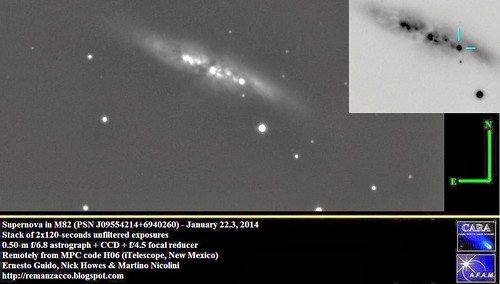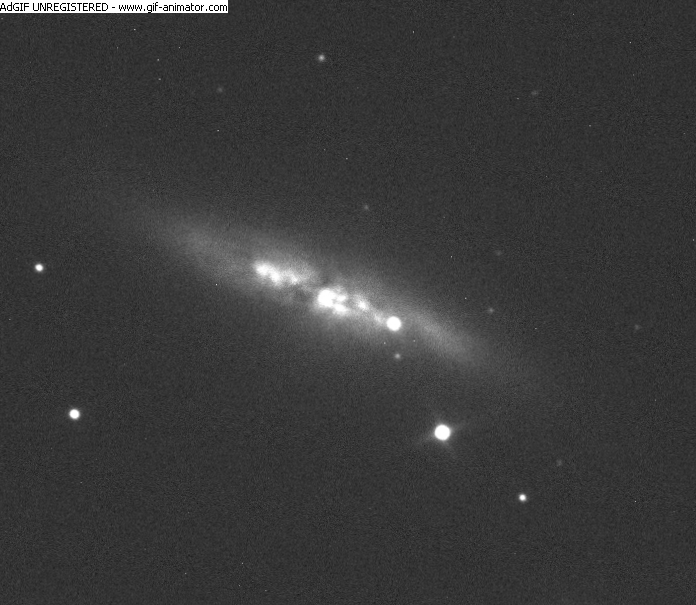Special Guest Blog: Things That Go “Pop” in the Night
- By Maggie Masetti
- February 11, 2014
- Comments Off on Special Guest Blog: Things That Go “Pop” in the Night
We have an extra-special guest blog today! Nick Howes, astronomer at the Kielder Observatory in the UK, collaborator on a range of NASA programs and Pro-Am Programme Manager for the Faulkes Telescope Project, explains the significance of the new supernova detected in nearby galaxy Messier 82.
Stars have a life cycle; they form from vast clouds of dust over millions and millions of years, eventually igniting into the nuclear furnaces that light up our skies at night.
Our own Sun, which formed around 4.5 or so billion years ago, is a good example of an average sized main-sequence star, which, when it runs out of its nuclear fuels in around another 4+ billion years or so, will eventually expand outwards in to a red giant star. It will engulf possibly even the orbit of our Earth, devouring Mercury and Venus before eventually leaving behind a beautiful shell known as a planetary nebula, and the remnants of its former life in the form of a white hot dwarf star. No need to worry though, with this being billions of years ahead, we can continue to enjoy its life giving rays.
But spare a thought for the inhabitants of a star system in the relatively nearby galaxy Messier 82. The 82nd object cataloged by Charles Messier when doing his survey, the “Cigar” Galaxy, as it is known recently (in Earth terms), gave astronomers something to quite literally jump up and down in joy over. Around 11.5 million years ago, a star in this galaxy exploded, in one of the most violent events in the Universe – a supernova.

M82, captured by the Hubble Space Telescope. Credit: NASA, ESA, and The Hubble Heritage Team (STScI/AURA)
Our Sun won’t suffer this fate, due to its size, and no stars have been seen to explode in our own galaxy for hundreds of years. Even this dramatic event is one of the closest in decades, and the closest of its type (Supernova type 1a) in a very long time.
Type 1a supernova are important as they give astronomers a kind of “standard candle” to use to measure cosmic expansion. It was the use of this method which led to the discovery of so-called “Dark Energy,” and the eventual winning of the Nobel Prize for Physics by the team who’d made this monumental find.
The close proximity of this supernova, at under 12 million light years, a mere stone throw away in cosmic scales, has astronomers very excited. This is because it is a type 1a of course, but also because at this distance, so many large telescopes (ranging from optical through the x-ray and even down to radio wavelengths) will be able to study it.
The beauty of this story though is not so much in the science that is to come, but in the discovery itself. Messier 82 is probably one of the most photographed objects in the Northern Hemisphere night sky. Sitting near to the two front pointer stars in the constellation of Ursa Major (the ones which point towards the pole star), M82 and the other nearby galaxy M81 make a wonderful photographic opportunity even in small and modest sized amateur telescopes.

Location of M82 – click to enlarge. Copyright: NASA, ESA, Z. Levay (STScI) and A. Fujii
On the night of January 21st at around 19:20 UT, a group of students and their lecturer, Dr Steve Fossey, at University College London, were imaging the Galaxy. They picked up that something was different, and that something appeared to have eluded everyone else for more than a week.

Discovery image. Credit: UCL/University of London Observatory/Steve Fossey/Ben Cooke/Guy Pollack/Matthew Wilde/Thomas Wright
Messier 82 has a high surface brightness, so many imagers, who aim to snap the outer “starburst” aspects of the galaxy, can tend to overexpose the core regions, which is where this new star was cunningly hidden. Images taken by Japanese and Chinese astronomers as well as many others in the week previous all, after further inspection, seemed to show the supernova, growing in brightness. But still, nobody reported it until that fateful night in London.
Even an online star party, where dozens of eager amateurs were glued to screens looking at images coming in live of the galaxy failed to spot it, giving Dr Fossey and his group of students their shot at immortality.
Now, with almost every major telescope on Earth and even those in orbit targeting the supernova, which is expected to peak in the next few weeks at around magnitude 10 (visible from good dark skies in larger binoculars), the science will really begin, with spectra, and other science data pouring in for analysis.

Confirmation image of the M82 supernova by Ernesto Guido, Nick Howes and Martino Nicolini
My own team, using a range of robotic telescopes around the world, are closely monitoring this supernova as it evolves, and we’ve asked many students who have access to the Faulkes Telescopes to image it, which will enable them to create detailed light curves showing the supernova as it evolves, bringing exciting science once more in to the classroom.

New animation showing a comparison between an image taken on January 23, 2014 and an archive image (dated back to 2013-11-22) both by 2-meter Faulkes Telescope North (operated by LCOGT). Animation by E. Guido, N. Howes & M. Nicolini.
We wanted to note that just as Nick was completing this article, his team also got the confirmation images on another supernova in the Galaxy Messier 99!


